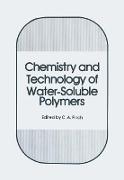Chemistry and Technology of Water-Soluble Polymers
BücherAngebote / Angebote:
To the biochemist, water is, of course, the only solvent worthy of consideration, because natural macromolecules exhibit their remarkable conformational properties only in aqueous media. Probably because of these remarkable properties, biochemists do not tend to regard proteins, nucleotides and polysaccharides as polymers in the way that real polymer scientists regard methyl methacrylate and polyethylene. The laws of polymer statistics hardly apply to native biopolymers. Between these two powerful camps, lies the No-man's land of water soluble synthetic polymers: here, we must also include natural polymers which have been chemically modified. The scientific literature of these compounds is characterized by a large number of patents, which is usually a sign of little basic understanding, of 'know-how' rather than of 'know-why'. Many of the physical properties of such aqueous solutions are intriguing: the polymer may be completely miscible with water, and yet water is a 'poor' solvent, in terms of polymer parlance. ~kiny of the polymers form thermorever sible gels on heating or cooling. The phenomena of exothermic mixing and salting-in are common features of such systems: neither can be fully explained by the available theories. Finally, the eccentric behaviour of polyelectrolytes is well documented. Despite the lack of a sound physico-chemical foundation there is a general awareness of the importance of water soluble vinyl, acrylic, polyether, starch and cellulose derivatives, as witnessed again by ~he vast patent literature.
Folgt in ca. 15 Arbeitstagen




